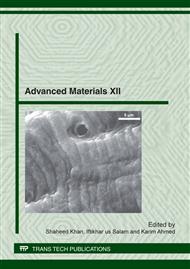p.343
p.348
p.356
p.364
p.371
p.378
p.386
p.394
p.399
Improved Hydrogen Desorption Kinetics of MgH2 Nanoparticles by Using TiC Nanocatalyst
Abstract:
Magnesium hydride (MgH2) is considered to be a promising hydrogen storage material because of its high gravimetric and volumetric storage capacities. However, its slow kinetics and high desorption temperature (> 300 °C) limit the practical applications. We have selected TiC nanoparticles to modify the hydrogen storage properties of MgH2. First, Mg nanoparticles were synthesized by thermal desorption of bipyridyl complex of Mg and then MgH2 nanoparticles were obtained by hydriding the Mg nanoparticles. Composite mixtures (MgH2 + TiC) were prepared using high-energy ball milling. Structural analysis, morphology and particle size were investigated by X-rays diffractometer (XRD) and scanning electron microscopy (SEM) respectively. Hydrogen desorption properties of MgH2 was investigated with various amount of TiC nanocatalyst using differential scanning calorimetry (DSC) and seivertz type apparatus (PCT). Desorption kinetics were also studied by pressure composition isotherm (PCI). Results show that the product reveals good reversible hydrogen absorption-desorption cycles even at >150 °C. The hydrogen desorption kinetics of catalyzed and noncatalyzed MgH2 could be understood by a modified first-order reaction model, in which the surface condition was taken into account.
Info:
Periodical:
Pages:
371-377
Citation:
Online since:
May 2012
Authors:
Keywords:
Price:
Сopyright:
© 2012 Trans Tech Publications Ltd. All Rights Reserved
Share:
Citation:


